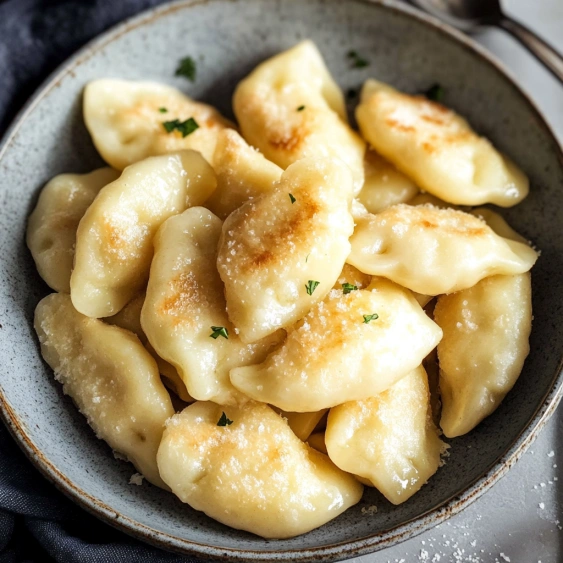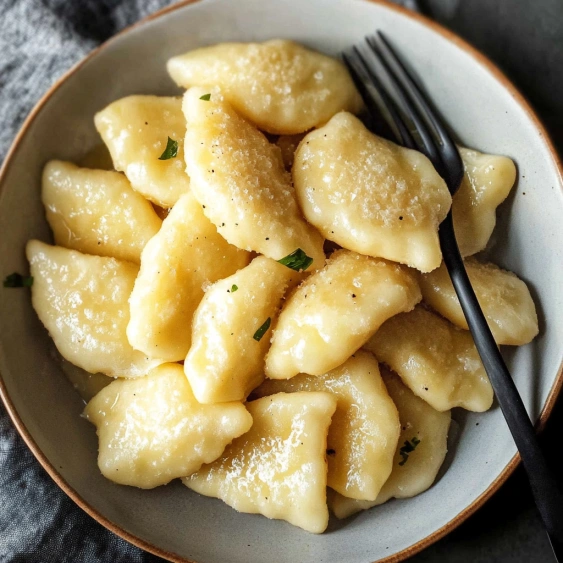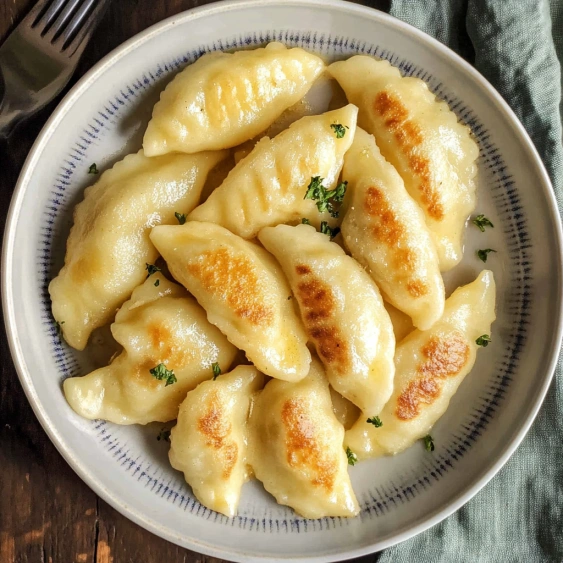 Pin it
Pin it
This delightful Polish lazy pierogi recipe delivers all the flavor of traditional pierogi with a fraction of the effort. These tender, cheese-filled dumplings are a beloved comfort food in Polish cuisine, perfect for busy weeknights when you crave something homemade but lack the time for elaborate cooking.
I discovered this recipe during a winter visit to my Polish neighbor, who showed me this family shortcut for enjoying pierogi flavors without the time-consuming dough folding. Since then, it's become my go-to dish whenever nostalgia for Eastern European comfort food strikes.
Ingredients
- Twaróg cheese full fat: 8.82 ounces (250g) provides the authentic tangy flavor that defines this dish. Look for Polish farmer's cheese or substitute with drained cottage cheese if unavailable
- All-purpose flour: ½ cup less 1½ tbsp (50g) gives structure without making the dumplings tough. Use a light touch when measuring
- Large egg: acts as the binding agent that holds everything together
- Fine sea salt: ⅕ teaspoon enhances all flavors without making the dish salty
- Melted butter: 2 tablespoons creates the rich finishing touch that makes these dumplings irresistible
- Sugar: 2 tablespoons adds the traditional sweet contrast that balances the tangy cheese
Step-by-Step Instructions
- Boil Water:
- Fill a medium pot with water and add approximately 1 teaspoon of salt for every 3 liters. Cover and bring to a boil while you prepare the dumpling mixture. Having the water ready ensures you can cook the dumplings immediately after shaping them.
- Mash Twaróg:
- Place the cheese in a large shallow bowl and work it with a potato masher for several minutes. Continue until the texture transforms from crumbly to creamy and cohesive. This step is crucial for achieving the right consistency in your final dumplings.
- Add Egg:
- Introduce the egg and salt to your mashed cheese. Continue mashing and stirring until the egg is completely incorporated and no streaks remain. The mixture will become slightly more loose and glossy at this stage.
- Add Flour:
- Incorporate the flour using the back of a large spoon, mixing thoroughly until fully combined. The resulting mixture should be sticky this is exactly what you want. Resist adding extra flour even if the dough seems too wet, as this will make your pierogi tough.
- Shape Lazy Pierogi:
- Dust your work surface with a light coating of flour. Using a spoon, transfer about one-third of the mixture onto the floured surface. With floured hands, gently roll the mixture into a long sausage shape approximately the thickness of a large thumb. Flatten the roll slightly, then cut at a slight angle into small pieces about ½ inch (1.5cm) thick. Place the cut dumplings on a floured surface, ensuring they don't touch each other.
- Boil Dumplings:
- Reduce the heat so the water isn't rapidly boiling, then carefully add dumplings one by one. Stir gently with a wooden spoon to prevent sticking. Once the dumplings float to the surface, cook for exactly one minute more. Work in batches to avoid overcrowding, which would lower the water temperature and make the dumplings soggy.
- Serve:
- Using a slotted spoon, transfer the cooked dumplings to a lightly buttered plate. Drizzle with melted butter and sprinkle with sugar according to your taste preference. Serve immediately while still warm for the best texture and flavor experience.
 Pin it
Pin it
I particularly treasure the twaróg cheese in this recipe. My Polish grandmother would always say the quality of the cheese determines the soul of the dish. Once, when I couldn't find proper twaróg, I substituted ricotta, and while still delicious, family members immediately noticed the difference in that subtle tanginess that makes these pierogi special.
Storage Solutions
These lazy pierogi store remarkably well in the refrigerator for up to three days. Place them in an airtight container, but avoid stacking without parchment paper between layers as they tend to stick. To reheat, either microwave gently with a damp paper towel cover or warm in a skillet with a touch of butter until heated through. The texture remains surprisingly good even after refrigeration.
Smart Substitutions
If authentic twaróg proves difficult to find, several alternatives work well. Farmer's cheese is the closest substitute, followed by well-drained cottage cheese (press through a fine sieve to remove excess moisture). In a pinch, a mixture of ricotta and a small amount of sour cream can approximate the texture and tanginess. For those avoiding wheat, this recipe adapts beautifully to gluten-free flour blends that contain xanthan gum.
Serving Traditions
In Polish homes, lazy pierogi often appear as both a main dish and a dessert, depending on the toppings. Beyond the classic butter and sugar combination, try toasted breadcrumbs fried in butter (a traditional Polish topping called "kruszonka"), sour cream and fresh fruit, or caramelized onions for a savory variation. Many Polish families serve these alongside a simple cucumber salad dressed with sour cream and dill for a complete meal.
 Pin it
Pin it
Frequently Asked Questions
- → What is twarόg cheese and can I substitute it?
Twarόg is a Polish fresh farmer's cheese with a slightly tangy flavor and crumbly texture. You can substitute with farmer's cheese, quark, or dry cottage cheese (pressed to remove excess moisture). In a pinch, ricotta mixed with a bit of sour cream can work, though the flavor will be milder.
- → Why is the dough supposed to be sticky?
The sticky consistency is essential for proper texture. Adding too much flour will make the dumplings dense and tough. The small amount of flour helps bind the cheese while keeping the pierogi soft and tender when cooked.
- → Can I add other flavors to lazy pierogi?
Absolutely! Traditional variations include adding mashed potato, cinnamon, vanilla, or lemon zest to the dough. For toppings, try fruit compote, sweetened sour cream, fried breadcrumbs, or savory options like fried onions and bacon bits.
- → Can lazy pierogi be made ahead of time?
Yes, you can make them ahead and reheat. Cook as directed, then cool completely. Store refrigerated for 2-3 days. To reheat, either boil briefly (30 seconds), pan-fry in butter until golden, or microwave with a damp paper towel covering them.
- → Why are they called 'lazy' pierogi?
They're called 'lazy' (leniwe) because they skip the most labor-intensive steps of traditional pierogi making - preparing separate filling and folding individual dumplings. The cheese is incorporated directly into the dough, making them much quicker and easier to prepare while still delivering similar flavors.
- → How do I know when the pierogi are cooked properly?
Properly cooked lazy pierogi will float to the surface of the water. Once they float, cook for just 1 minute more. Overcooking can make them mushy, while undercooking results in a doughy center. They should be soft but still hold their shape when removed from the water.
